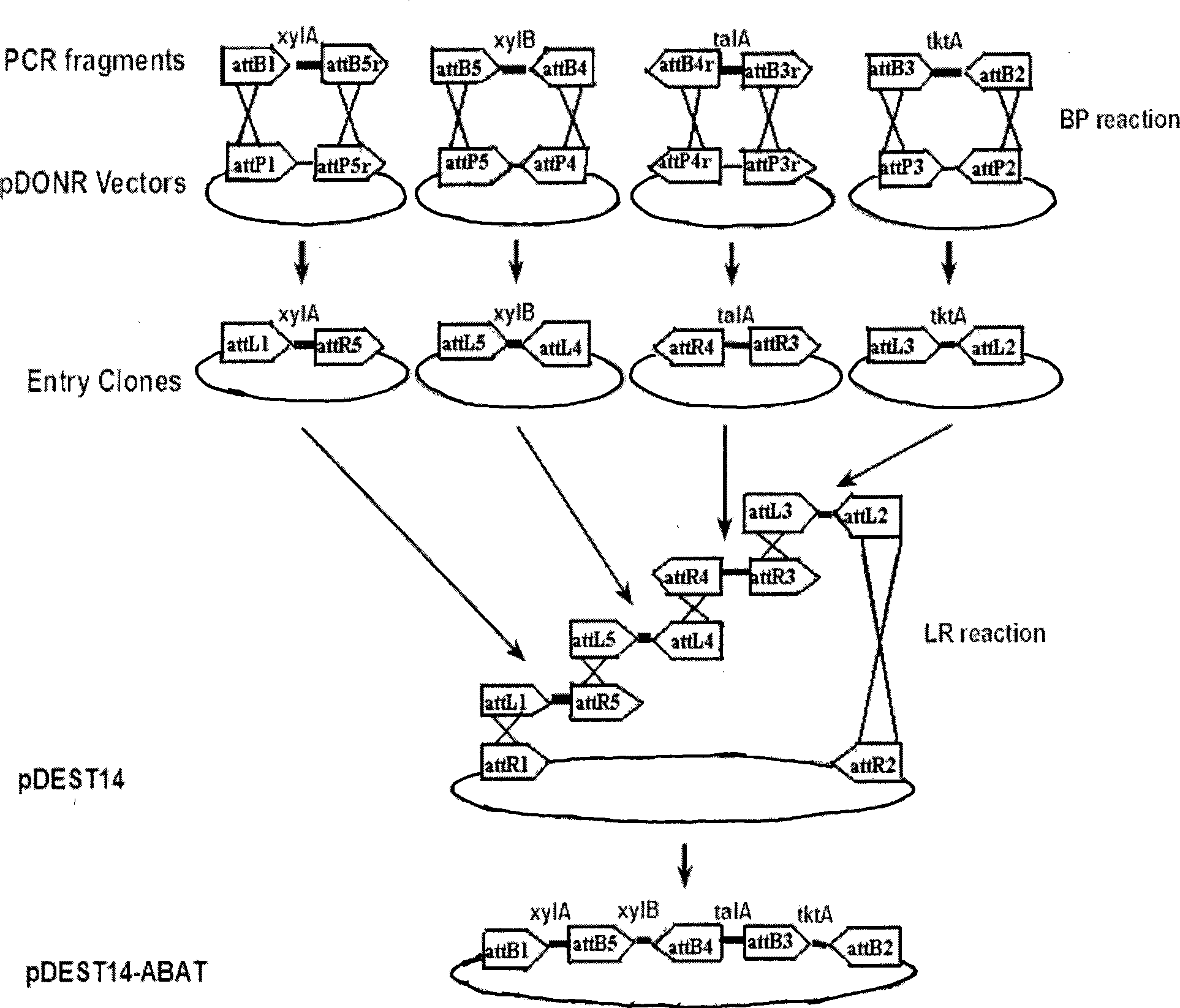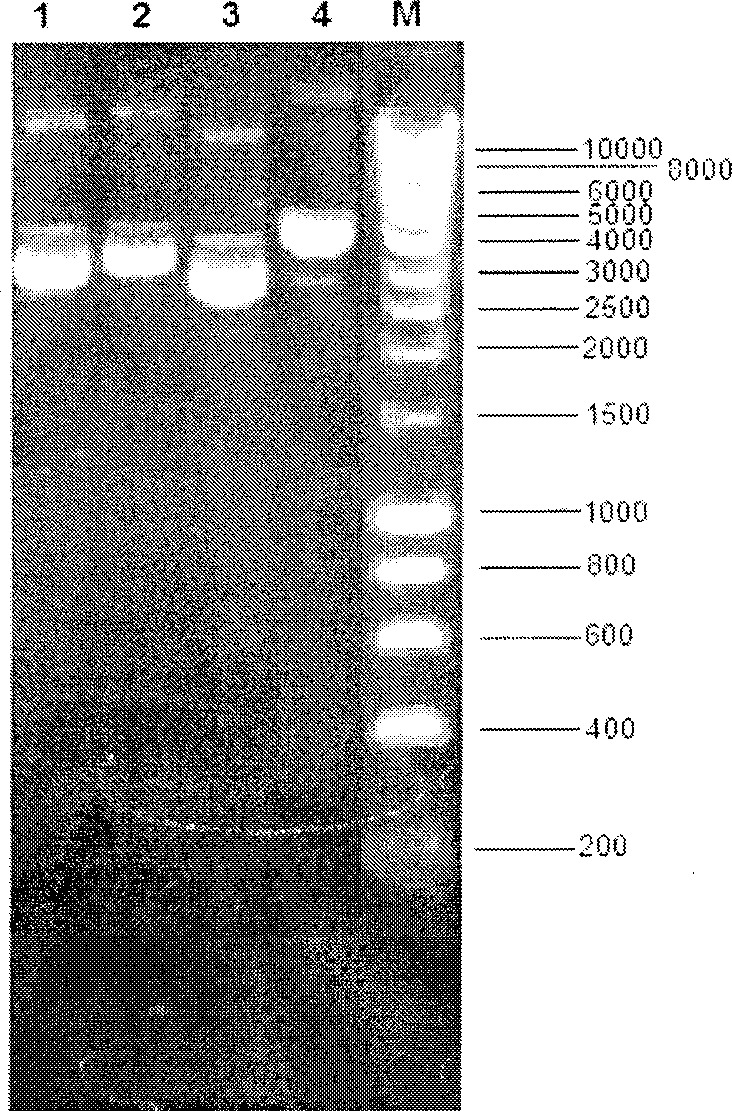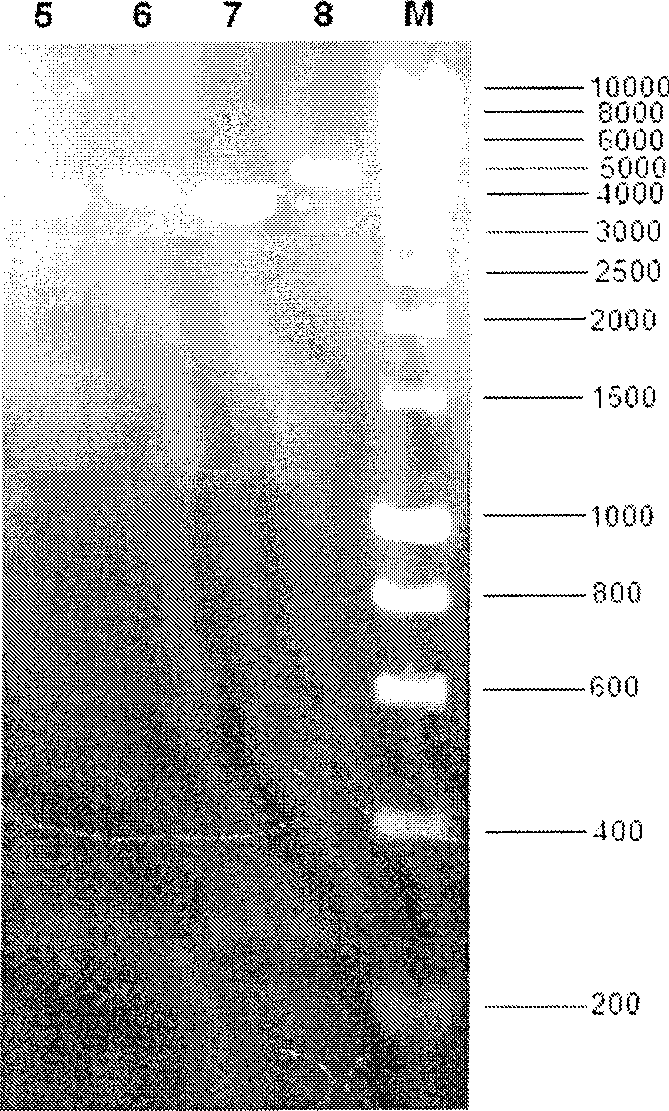Broad host range plasmid carrying xylose metabolism related gene and construction method thereof
A technology of xylose metabolism and construction method, which is applied in the field of plasmid construction, can solve the problems of low raw material utilization rate and high production cost of cellulosic ethanol, and achieve the effect of shortening the experiment cycle and reducing production cost
- Summary
- Abstract
- Description
- Claims
- Application Information
AI Technical Summary
Problems solved by technology
Method used
Image
Examples
Embodiment 1
[0081] Example 1 Construction of Entry Clones
[0082] 1.1 Construction of entry clone pENTRY221-L1-xylA-R5 containing xylose isomerase gene (xylA)
[0083] Amplify the attB1-xylA-attB5r fragment: E. coli DH5α (Invitrogen, Cat. No. 18263-012) was used as the source strain of the target gene, according to the sequence data on GeneBank (Accession Number: U00096) xylA gene corresponding to 3727444- 3728900 nucleotides, and attB1 and attB5r recombination fragments were introduced at both ends of the gene, and the primers were designed as follows:
[0084] Upstream primer attB1-xylA_for (57bp):
[0085] GTGAATTATCTCAATAG
[0086] attB1
[0087] CAGTGTGAA-3' (SEQ ID No: 2)
[0088] Downstream primer attB5r-xylA_rev (49bp):
[0089] CAACGGACTGCACAGTTAGCCG
[0090] attB5r
[0091] -3' (SEQ ID No: 3)
[0092] Using Taq DNA Polymerase (Sigma, Cat.No.D1806), the PCR reaction system is as follows:
[0093] 10×PCR Buffer 5.0μl
[0094] dNTP mix (10mM each)...
Embodiment 2
[0225] Example 2 Construction of pDEST14-ABAT plasmid
[0226] Use pDEST14 plasmid (Invitrogen) to carry out LR recombination reaction with the obtained 4 entry clones, see pDEST14-ABAT plasmid construction procedure figure 1 , dilute the 4 entry clones to about 10 fmoles / μl, the reaction system is as follows:
[0227] pENTRY221-L1-xylA-R5
[0228] pENTRY221-L5-xylB-L4 1.0μl each
[0229] pENTRY221-R4-talA-R3
[0230] pENTRY221-L3-tktA-L2
[0231] pDEST14 (20fmoles / μl) 1.0μl
[0232] 1×TEBuffer, pH 8.0 3.0 μl
[0233] LR Clonase TM Plus enzyme mix (Invitrogen, Cat. No. 12538-120) 2.0μl
[0234] Total Volume 10.0μl
[0235] After reacting at 25°C for 16 hours, add 1 μl of proteinase K (Invitrogen, Cat. No. 12537-104), and incubate at 37°C for 10 minutes.
[0236] Transformation E.coli One Shot Mach1 TM T1R competent cells (Invitrogen, Cat.No.C8620-03), coated with LB resistance plates containing 100mg / L ampicillin, picked positive clones, cultured and expanded wi...
Embodiment 3
[0237] Example 3 Construction of pBBR1MCS2-ABAT plasmid
[0238]The pDEST14-ABAT plasmid was double-digested with Xba I (Takara, Catalog No. D1093A) and Nhe I (Takara, Catalog No. Dll62A) (which is the same tail enzyme as Xba I and produces the same sticky end), and the pBBR1MCS2 plasmid was single-digested with Xba I. Enzyme cutting, the enzyme cutting system is as follows:
[0239]
[0240] The pBBRlMCS2 plasmid (Kovach et al 1995, presented by Dr. Wei Huang, University of Sheffield, see Image 6 ) was dephosphorylated with Xba I single-digestion product, pDFST14-ABAT plasmid was double-digested with Xba I and Nhe I to obtain a 7096bp ABAT fragment, and the two were carried out with QIAquick Gel Extraction Kits (QIAGEN, Cat.No.28706) Recovery and purification. The purified ABAT fragment and the vector pBBR1MCS2 were ligated with T4 DNA ligase (hkara, Cat.No.D2011A), and the ligation reaction system was as follows:
[0241]
[0242] Mix the above system evenly, centr...
PUM
 Login to View More
Login to View More Abstract
Description
Claims
Application Information
 Login to View More
Login to View More - R&D
- Intellectual Property
- Life Sciences
- Materials
- Tech Scout
- Unparalleled Data Quality
- Higher Quality Content
- 60% Fewer Hallucinations
Browse by: Latest US Patents, China's latest patents, Technical Efficacy Thesaurus, Application Domain, Technology Topic, Popular Technical Reports.
© 2025 PatSnap. All rights reserved.Legal|Privacy policy|Modern Slavery Act Transparency Statement|Sitemap|About US| Contact US: help@patsnap.com



